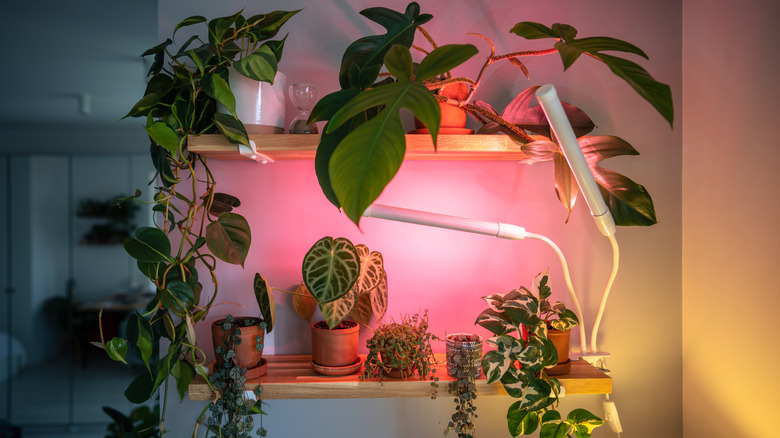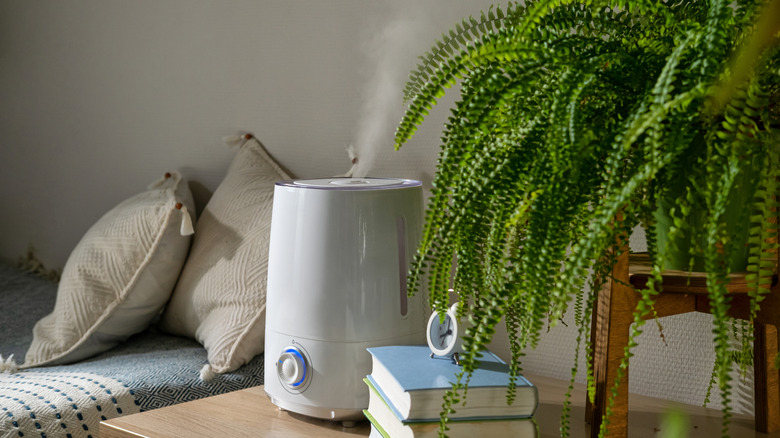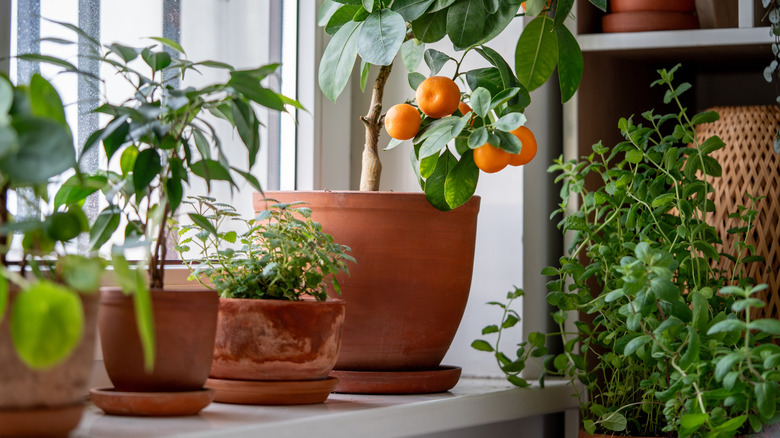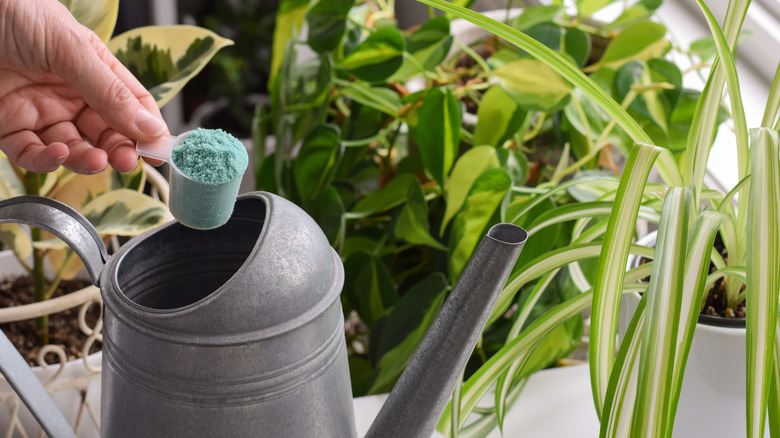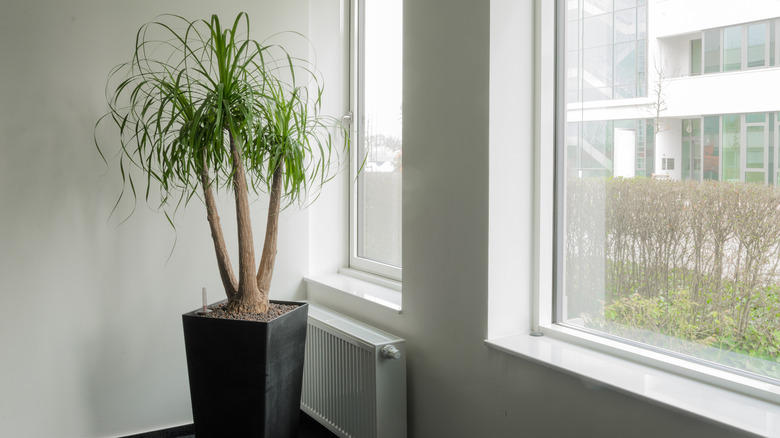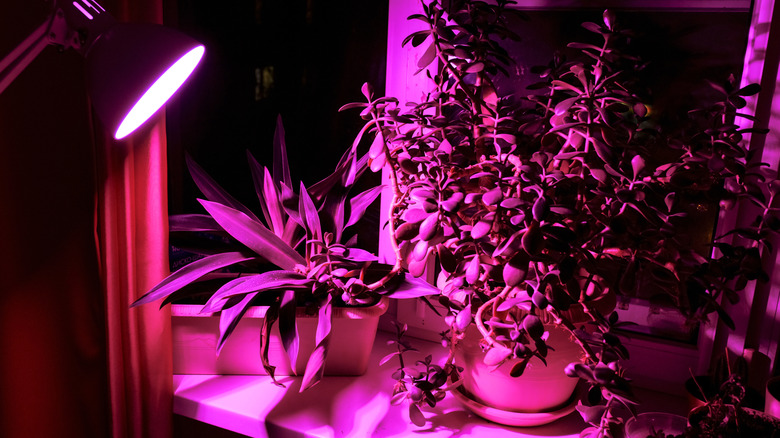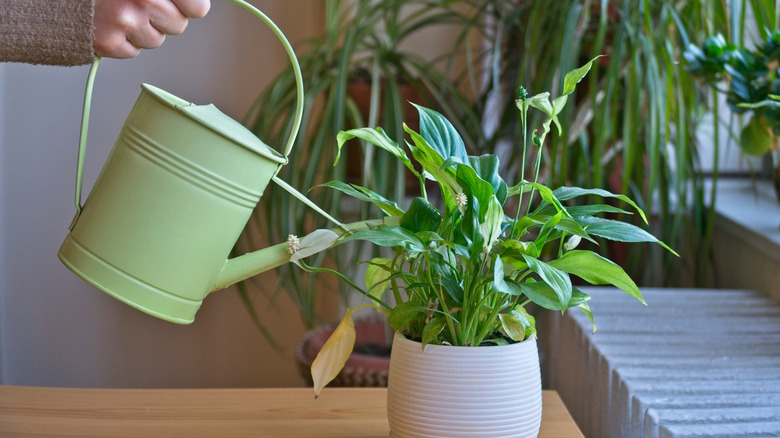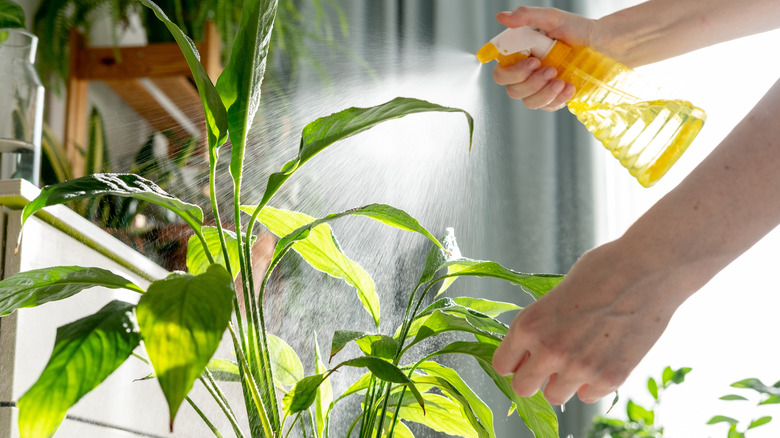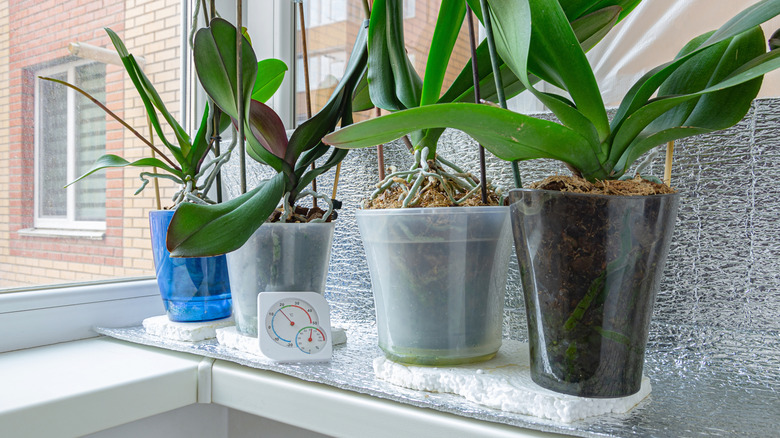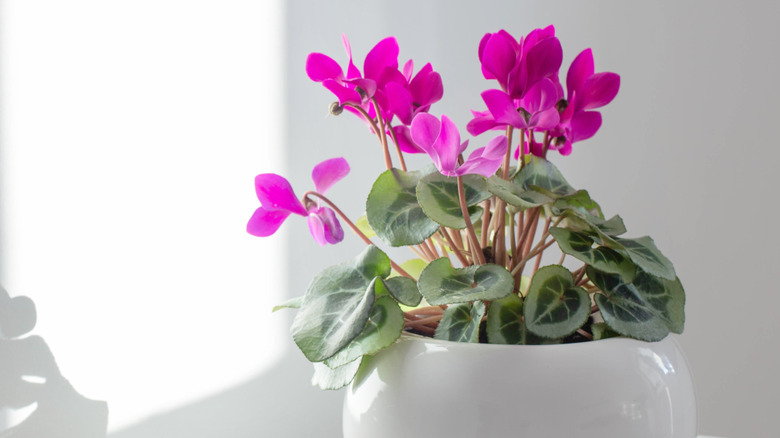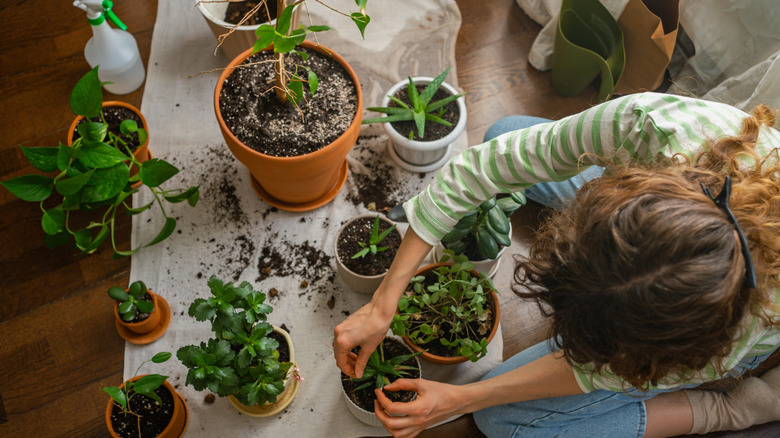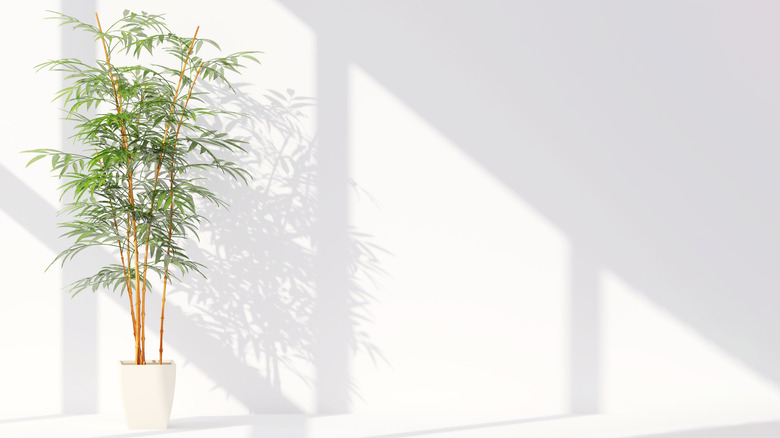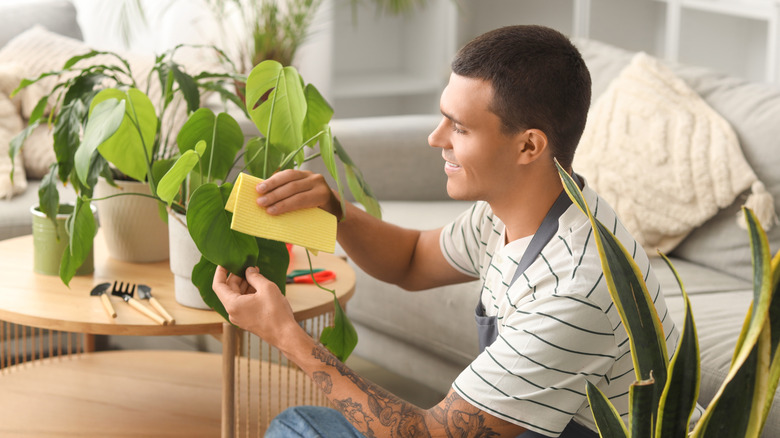13 Ways To Tweak Your Houseplant Care Routine For Winter
We may receive a commission on purchases made from links.
You might already know all the ways you need to prepare your yard for winter — but what about your indoor plants? Sure, it might seem like there's nothing about your houseplant care routine you need to change for the season — after all, they stay indoors all year round. But believe it or not, winter can impact your indoor plant care routine significantly, and your plants are likely to suffer if you don't adjust your care routine appropriately.
How often you fertilize and water your plants during winter matters — and you might even need to move where you put your houseplants in your home, too. There are also some things you should do to prepare your houseplants for winter, like finding appropriate insulation for them (yep, indoor plants need insulating, too) or sealing up your draftiest windows. These factors can help prevent your plant from becoming overly stressed, falling victim to disease or root rot, and even dying during winter. To help your houseplants thrive all year long and guarantee beautiful blooms come spring, make sure you follow these tips for adjusting your indoor plant care routine for winter.
Increase the humidity in rooms where you have houseplants
Along with winter comes dry air, which means the humidity your plants normally enjoy during spring and summer is no longer available to them (even indoors). Especially for tropical houseplants, this can have negative effects; you might notice your plants' leaves shriveling up or see them struggling to grow. In order to help your houseplants stay comfortable all winter long, you need to artificially increase the humidity. One great way of doing this is to put all of your houseplants in one room with a humidifier. If you have a digital humidity gauge, you'll always have an accurate reading for how much humidity your plants are being exposed to and can turn on the humidifier when the air drops below 30 percent.
There are budget-friendly options for increasing your plants' humidity, too — and these alternatives also work well if you're not able to place your plants in an enclosed space with a humidifier. One option is to place a tray or plant saucer with some pebbles directly underneath your plant's pot, and fill the tray with water. As the water evaporates, it will increase the humidity around your plant. Another option is to occasionally pop your tropical plants in the bathroom while you take a hot shower; the steam will give them a burst of humidity much like a tropical shower would in their native environment.
Consider moving your plants away from the windows, not towards them
When winter hits, your first inclination might be to move your houseplants towards your windows so that they can get more light. However, in some cases, this can expose your plants to colder temperatures from outside. Windows, especially ones that aren't thick, typically get very cold or even gather frost during winter; you want to ensure that your plant's leaves aren't touching the window. Even that might not be enough to protect your plants from the chill; if your windows are drafty or you notice that the temperature drops directly next to them, you should move your plants away from the windows while it's cold outside.
Try to move your plants to a spot in your home where they can still receive sufficient light; putting a small bench or side table near the windowsill they would otherwise sit on can be a good move. You can also help your plants stay warm by checking your windows for drafts and sealing them up for winter.
Don't fertilize if your plant isn't growing in winter
Many indoor houseplants have a dormancy period that can occur during winter. These periods often begin when the plant receives less light during winter, so your houseplants know when to go dormant even if the temperature in your home doesn't change. Even for your indoor plants, a dormant period is all about helping them survive and conserve energy during winter. It's important to allow your indoor houseplants to go dormant during winter if they need a dormant period, which means that you'll likely see them pushing out less (or no) growth than you would throughout the rest of the year. Some examples of plants that go dormant are cyclamens or ZZ plants.
While your plants are resting, don't fertilize them. Fertilizing your plants during winter will just give the soil too many nutrients that your houseplants can't use, which could cause them to become stressed and even die. Wait to fertilize until spring rolls around, or until you start seeing your plant pop out new growth again. If a houseplant continues to produce new leaves, stems, or flowers during winter, it may benefit from a light feeding because it is still in active growth. Check with a professional at a local garden center to find out if your houseplant will need to be fertilized over the winter.
Make sure your plants aren't too close to the heater
During a cold snap, you might feel tempted to protect your houseplants by putting them right next to your heater. While this seems like a great way to keep them warm, it can actually damage their leaves. The intense heat from your heater can cause your plant's leaves to brown or even burn — once this happens, the leaves just can't be saved. Your plant's leaves will drop if they turn completely brown — which isn't a good thing during winter, because they need their leaves to soak up as much light as possible during the darker months.
Instead, keep your plants far away from any heaters, radiators, or warm air paths in your home. Place them outside of the direct path of a vent or heater, keeping them warm without risking their leaves.
Use grow lights for plants as needed
Some of your plants might not enjoy the winter season as much as others due to the lack of light. If your plant doesn't need a strict dormancy period, you might want to use grow lights to keep your houseplant healthy all year round. There are a wide range of grow lights you can pick depending on your needs; some grow lights are meant for individual plants, so that you can give a single plant a focused grow light. Others can shine across an entire shelf of plants. Your average lightbulb won't work as a grow light — instead, you should look for lightbulbs that are full-spectrum or daylight bulbs. LED lights are some of the best grow lights for indoor plants, since they don't get too hot. You might also see grow lights that are a certain color, as these different wavelengths can help your plants in unique ways — blue light helps your plants' leaves and stems develop, for example.
It's worth noting that some plants prefer a decrease in light during winter, and these plants shouldn't be given grow lights (or they should be set to a shorter timer than other plants). For example, poinsettias need total darkness for 14 hours daily in winter in order to induce their flowering process. Others, like peace lilies, generally are plants that tolerate low light, and might not need too much supplemental light.
Change your watering routine
If your houseplants go dormant during winter (or even just slow their growth), chances are, they won't need much water. You should adjust your watering routine based on which of your plants are still growing — and how much. Even if your plants put out growth all year round, you'll probably notice they grow at least a little slower during winter. A lack of sunlight might also mean that the water in your pots' soil doesn't evaporate as quickly as it does during summer. This makes it likely that your plants will need less water than you're used to giving them the rest of the year.
You should be prepared to monitor your plants' water level closely during winter, so that you can avoid accidentally overwatering your houseplants. Getting your hands on a soil moisture meter, like this Digital 4-In-1 Soil Moisture Meter from Amazon, can be a handy tool to determine your new winter watering schedule. Don't forget to keep an eye out for signs that you might be overwatering your plants, too, like waterlogged soil or yellowing leaves.
Don't drop your home's temperature
It's tempting to save money during the winter by dropping the temperature of the home and bundling up. The same thing goes for if you need to leave the house for a week or two during winter; it's common to drop the temperature by several degrees to save energy. Unfortunately, this can have a negative effect on your houseplants. The sudden temperature drop can send them into shock, at which point they're extremely vulnerable and could suffer.
To avoid harming your plants, always make sure that at least one room in your home is set to a consistent temperature. If you want to save energy during winter, move all of your plants into this room, set the thermostat to heat only that room, and shut the door; you can rest easy knowing that your plants will be happy even when the rest of the house gets cold. If you do need to lower the temperature slightly during winter, never drop it beneath what your most sensitive plant can handle. Remember that the lowest temperature a plant can survive is different than the temperature range it can thrive in; if you want your plants to stay healthy through the entire season, you should make sure to have a space they can live in that remains at a comfortable temperature, no less than 55 degrees Fahrenheit at night on average, and warmer during the day.
Don't stop your pest control efforts
You might think that it's safe to relax your pest control efforts a bit during winter. However, winter is actually a time when you need to increase your pest vigilance. Dormant plants will fall victim to pests much more easily than they would otherwise. And even if it isn't pest season, uninvited guests may want to seek refuge in your warm, cozy home.
Continue your pest prevention methods all through winter. For indoor plants, natural pest control methods, like spritzing a diluted neem oil solution, are a good way to keep your plants pest-free. Don't forget to check your plant's leaves and soil for signs of bugs. Additionally, you can pest-proof your home for winter to discourage too many bugs from moving in when the weather turns.
Insulate your plants as best you can, even indoors
Protecting your plants from cold surfaces, like windows and windowsills, is important to help keep them warm — even while they're indoors. One good way to help insulate your plants from a cold surface is to set it on a plant saucer or coaster. If you do need to have your plants near a window, then you could try using cardboard, bubble wrap, or thick fabric to help insulate them from the chill outside, especially if you can't keep them away from a drafty window.
If you struggle with cold soil indoors, you could even try a bit of mulch for extra insulation. If, for any reason, you have to keep your home below ideal temperatures, you may want to consider something like a miniature indoor greenhouse; these often have heat-producing grow lights and temperature monitors that can help you insulate your plants from chilly drafts or cold rooms.
Some plants might actually require a cold period
You might want to consider looking into whether any of the houseplants you own can actually benefit from slightly lower temperatures. For example, slightly colder nighttime temperatures can help certain types of orchids to flower. A common beginner orchid, Phalaenopsis, can even benefit from a temperature drop of a few degrees during winter — that's one reason to keep this plant on your windowsill during cold weather rather than moving it someplace warmer. If you're caring for a young pitcher plant indoors over the winter, it may benefit from a cold period to grow — in fact, some pitcher plant owners will even pop theirs in the fridge during the winter months.
Even if your plant needs colder temperatures, you probably won't want to just dump them outside at night — not only does this expose them to pests and outdoor weather, but outdoor winter temperatures can sometimes be unpredictable. Instead, try placing your plants somewhere that gets slightly colder than the rest of the house during winter, such as a basement with grow lights or windows. You could also put them somewhere like a chilly windowsill to help them be exposed to slightly lower temperatures.
Repot your plants before winter begins
Plants go through a brief period of upset after being repotted. Repotting can cause them stress — and it's generally not a good idea to expose your plant to multiple stressors in a short period of time. It's best to avoid repotting your indoor plant right before temperatures drop in the winter — and you especially don't want to repot them right before they enter dormancy, as this could disrupt their usual routine.
You should help your plant adjust to its new pot during fall at the latest, well before winter sets in. Check your pots during late summer or early fall to see which plants will need repotting, and make sure you complete the job before temperatures drop and light becomes scarce. If you have a plant that needs repotting during winter, wait until spring if possible — unless you've got a repotting emergency on your hands, such as when you're trying to free a plant from a pest infestation.
Rotate your pots regularly to make sure they're getting lots of light
Another great thing you can do for your indoor plants during winter is to rotate them regularly. Because your plants won't be getting as much sun as usual during the winter, it's important to help expose all of your plants' leaves to as much sunlight as possible. Turning your plants encourages equal growth across the entire plant. It can even help your plant fill out more, too.
You should try rotating your plants slightly every week or so. If your plant is in a room with a lot of windows that get mostly equal light on all sides, this may not be necessary. But for plants that just don't get as much sun as they need during winter, rotating them is a good way to keep them healthy.
Wipe your plant's leaves (and inspect them, while you're at it)
Wiping down a plant's leaves will clear the dust and grime off, leaving more room for the plant to soak up as much sun as it can. To help your plants stay clean, wipe them down every few weeks, or as soon as you start to see dust gather (you can even dust your plant gently with a duster if you prefer). We have to admit that it also helps your plant look good; clean, glossy leaves are an indicator of plant health, and make your plants look more appealing.
Wiping down your plant's leaves is also a great chance to look for (and wipe off) tiny pests that you might have missed. Use a flashlight while you're wiping down your plant to check for signs of pests. At the same time, you can also look for signs of disease, such as changes on your houseplants' leaves or even fungal infection. Close examinations of your plants can help you catch these issues early on, when they're easier to treat.
